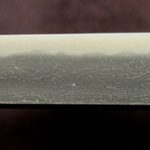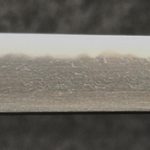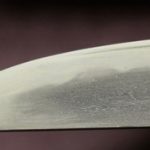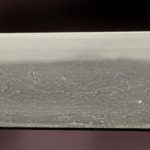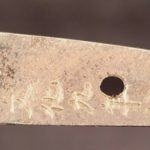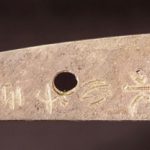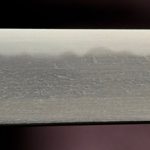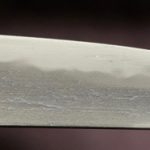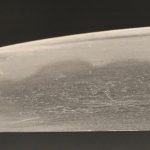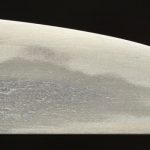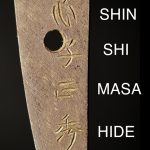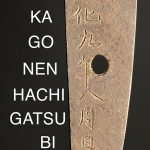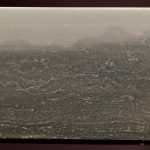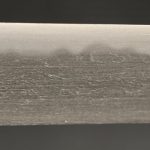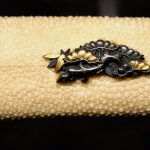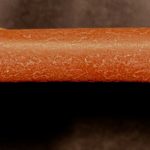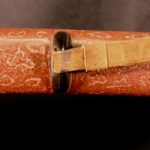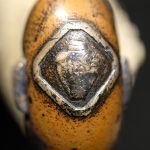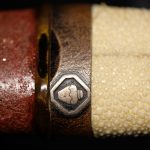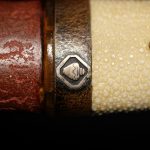SUISHINSEI MASAHIDE IN KOSHIRAE / SOLD
SUGATA: HIRA ZUKURI
MEI: SUISHINSI MASAHIDE
DATE: BUNKA GO NEN HACHI GATSU BI
NAGASA: 23.65cm (9.3125″)
OVERALL: 34.13cm (13.4375″)
MIHABA: 2.54cm (1″)
KASANE: 0.63cm (0.25″)
SORI: UCHI-ZORI
NAKAGO: UBU
MEKUGI ANA: ONE
YASURIME: SUJIKAI with KESHO YASURI
MUNE: IORI
HADA: ITAME with MASAME
HAMON: KO-MIDARE BASED ON SUGUHA
BOSHI: KOMARU
HORIMONO OMOTE: NONE
HORIMONO URA: NONE
HABAKI: 1 PC.
KOSHIRAE
Suishinshi Masahide is known as the founding father of the Shinshinto era. Born Suzuki Saburo in Dewa Province in 1750. He originally began as a blacksmith, but his goal was to be a sword smith. He moved to Sendai and began training as a sword smith, using the name Takuei. Later he moved to Musashi province and continued his training under Yasukuni and again changed his name to Terukuni. In 1774, he was hired by the Daimyo family, Akimoto. It was at this time he took the name Masahide.
With steady employment, Masahide was able to travel and study different styles of sword forging. It is documented that he was taught Bizen Den by Ishido Korekazu, and Soshu Den under Soshu Tsunahiro. For most of his career Masahide had devoted his efforts towards mastering Sukehiro’s toranba and Shinkai’s notare hamon.
Masahide, however, was much more than a simple swordsmith. He was also a theorist, author and teacher. Towards the middle of his career he changed his thoughts on forging. Masahide wrote that the flashy, wide hamon seen on so many swords of the time tended to break easily. He detailed in one of his three books, “Token Buyo Ron” some 25 examples of blades breaking. It was after his research, he made the decision to return to making functional, durable swords which cut well. This change in philosophy, theory and style was known as Fukkoto or sword revival, which was an effort to return to the forging techniques of the Heian and Kamakura periods.
As stated previously, Masahide was an excellent teacher. He was said to have trained over 100 swordsmiths including his two best students Hosokawa Masayoshi and Taikei Naotane.
While there were four linear famial generations of Masahide smiths, there were only three generations which used the mei Suishinsei Masahide. These were the 1st, 2nd, and fourth generations. The sandai or son of the nidai Masahide and heir to the school never used the name Masahide, instead he signed using the name Suishinsei Masatsugu. Masatsugu succeeded to head of the school in 1825 and died in 1860 at which time his son the Yondai or 4th generation Masahide assumed leadership of the school. Therefore, the linear 4th generation (son of the third generation) is known as the Sandai or 3rd generation Masahide.
In 1818, Shodai Masahide presented his son Sadahide, the Masahide name and changed his own name to Amahide.
As Masahide was a very famous smith, there are many fakes of his works/mei. Which brings us to the $100 question regarding this tanto. Is it shoshin or gimei? The short answer is I can not say either way with confidence. If this sword was mine opposed to a consignment, I would send it to shinsa to obtain their opinion prior to any decision to sell it. However, the owner is not interested in that route, so it is being sold as is. It is priced as gimei.
I have spent too many hours researching this tanto, and a combination of factors makes a reasonable conclusion extremely difficult. Let me explain, shodai Masahide made many, many swords in many different styles over a long career. The fact that there were three generations which used this mei, combined with the long career of the Shodai makes this a bit of a nightmare. The shodai began using this mei along with a few variants in 1774. He began using his koku’in seal in 1806. In 1818 he gave the Masahide name to his son and began signing his works Suishinshi Amahide.
So, as you can see he alone signed Suishinshi Masahide for 30+ years.
As with most smiths who work and sign their names over long time frames both deliberate changes and subtle nuances are seen in their works, Masahide is no different.
Add to that, there were 3 generations of Masahide smiths in this line. So, aside from the shodai, we are left with the nidai and yondai Masahide smiths, either of which could have made this sword. The problem is, I have found few if any photos or oshigata of known shoshin blades by these two generations.
Undoubtedly, this is a big, big name and it was faked a lot. Clearly the highest probability is that this tanto is gimei. Ultimately, while shinsa itself is merely an opinion, the only way to obtain the highest probability of whether it is shoshin or gimei is to refer it to the top nihonto scholars in the world via shinsa.
As such, this tanto is being sold at a price which would reflect a very fair price for a nice mumei tanto in koshirae. If this tanto passes shinsa, this would be a jackpot.
SOLD
If you would like to own this tanto contact me directly at yakiba.com@gmail.com
